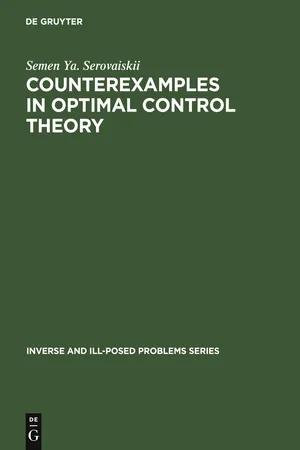
- 182 pages
- English
- PDF
- Available on iOS & Android
eBook - PDF
Counterexamples in Optimal Control Theory
About this book
This monograph deals with cases where optimal control either does not exist or is not unique, cases where optimality conditions are insufficient of degenerate, or where extremum problems in the sense of Tikhonov and Hadamard are ill-posed, and other situations. A formal application of classical optimisation methods in such cases either leads to wrong results or has no effect. The detailed analysis of these examples should provide a better understanding of the modern theory of optimal control and the practical difficulties of solving extremum problems.
Frequently asked questions
Yes, you can cancel anytime from the Subscription tab in your account settings on the Perlego website. Your subscription will stay active until the end of your current billing period. Learn how to cancel your subscription.
At the moment all of our mobile-responsive ePub books are available to download via the app. Most of our PDFs are also available to download and we're working on making the final remaining ones downloadable now. Learn more here.
Perlego offers two plans: Essential and Complete
- Essential is ideal for learners and professionals who enjoy exploring a wide range of subjects. Access the Essential Library with 800,000+ trusted titles and best-sellers across business, personal growth, and the humanities. Includes unlimited reading time and Standard Read Aloud voice.
- Complete: Perfect for advanced learners and researchers needing full, unrestricted access. Unlock 1.4M+ books across hundreds of subjects, including academic and specialized titles. The Complete Plan also includes advanced features like Premium Read Aloud and Research Assistant.
We are an online textbook subscription service, where you can get access to an entire online library for less than the price of a single book per month. With over 1 million books across 1000+ topics, we’ve got you covered! Learn more here.
Look out for the read-aloud symbol on your next book to see if you can listen to it. The read-aloud tool reads text aloud for you, highlighting the text as it is being read. You can pause it, speed it up and slow it down. Learn more here.
Yes! You can use the Perlego app on both iOS or Android devices to read anytime, anywhere — even offline. Perfect for commutes or when you’re on the go.
Please note we cannot support devices running on iOS 13 and Android 7 or earlier. Learn more about using the app.
Please note we cannot support devices running on iOS 13 and Android 7 or earlier. Learn more about using the app.
Yes, you can access Counterexamples in Optimal Control Theory by Semen Ya. Serovaiskii in PDF and/or ePUB format, as well as other popular books in Mathematics & Applied Mathematics. We have over one million books available in our catalogue for you to explore.
Information
Table of contents
- Preface
- Introduction
- 1. Problem formulation
- 2. The maximum principle
- 3. Example
- 4. Approximate solution of the optimality conditions
- Summary
- Example 1. Insufficiency of the optimality conditions
- 1.1. Problem formulation
- 1.2. The maximum principle
- 1.3. Analysis of the optimality conditions
- 1.4. Uniqueness of the optimal control
- 1.5. Uniqueness of an optimal control in a specific example
- 1.6. Further analysis of optimality conditions
- 1.7. Sufficiency of the optimality conditions
- 1.8. Sufficiency of the optimality conditions in a specific example
- 1.9. Conclusion of the analysis of the optimality conditions
- Summary
- Example 2. The singular control
- 2.1. Problem formulation
- 2.2. The maximum principle
- 2.3. Analysis of the optimality conditions
- 2.4. Nonoptimality of singular controls
- 2.5. Uniqueness of singular controls
- 2.6. The Kelly condition
- Summary
- Example 3. Nonexistence of optimal controls
- 3.1. Problem formulation
- 3.2. The maximum principle
- 3.3. Analysis of the optimality conditions
- 3.4. Unsolvability of the optimization problem
- 3.5. Existence of optimal controls
- 3.6. The proof of the solvability of an optimization problem
- 3.7. Conclusion of the analysis
- Summary
- Example 4. Nonexistence of optimal controls (Part 2)
- 4.1. Problem formulation
- 4.2. The maximum principle for systems with fixed final state
- 4.3. Approximate solution of the optimality conditions
- 4.4. The optimality conditions for Problem 4
- 4.5. Direct investigation of Problem 4
- 4.6. Revising the problem analysis
- 4.7. Problems with unbounded set of admissible controls
- 4.8. The Cantor function
- 4.9. Further analysis of the maximum condition
- 4.10. Conclusion of the problem analysis
- Summary
- Example 5. Ill-posedness in the sense of Tikhonov
- 5.1. Problem formulation
- 5.2. Solution of the problem
- 5.3. Ill-posedness in the sense of Tikhonov
- 5.4. Analysis of well-posedness in the sense of Tikhonov
- 5.5. The well-posed optimization problem
- 5.6. Regularization of optimal control problems
- Summary
- Example 6. Ill-posedness in the sense of Hadamard
- 6.1. Problem formulation
- 6.2. Ill-posedness in the sense of Hadamard
- 6.3. Well-posedness in the sense of Hadamard
- 6.4. A well-posed optimization problem
- Summary
- Example 7. Insufficiency of the optimality conditions (Part 2)
- 7.1. Problem formulation
- 7.2. The existence of an optimal control
- 7.3. Necessary condition for an extremum
- 7.4. Transformation of the optimality conditions
- 7.5. Analysis of the boundary value problem
- 7.6. The nonlinear heat conduction equation with infinitely many equilibrium states
- 7.7. Conclusion of the analysis of the variational problem
- Summary
- Example 8. The Chafee–Infante problem
- 8.1. Problem formulation
- 8.2. The necessary condition for an extremum
- 8.3. Solvability of the Chafee–Infante problem
- 8.4. The set of solutions of the Chafee–Infante problem
- 8.5. Bifurcation points
- Summary
- Comments
- Conclusion
- Bibliography